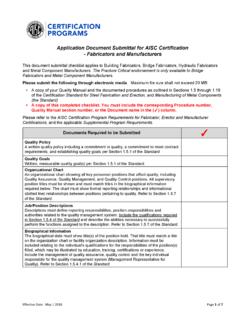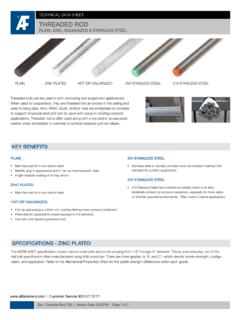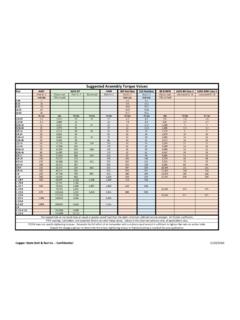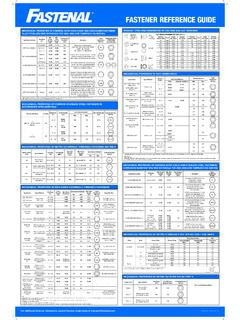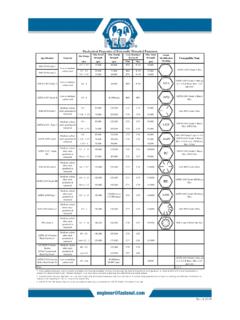Transcription of Anchor Rods - AISC
1 December 2004 Modern Steel ConstructionIn life there are a few things that arenecessary evils, and Anchor rods andcolumn base plate connections seem tobe one of them. These connectionshave caused problems on many build-ing projects, but by looking at the chal-lenges that others have faced and show-ing how these challenge have beensuccessfully overcome, perhaps we canmake the use of these important connec-tions more bearable. This article will givesome guidelines on how you can preventcommon problems in the design ofanchor rods and base plate connections,and will help the designer to avoidexpensive field repairs and scheduledelays.
2 Specifications and design guidesare already in place to aid in the design ofthese connections for strength, but issuesof constructability should be consideredon every project, to ease the constructionprocess. The following chart offers somecommon challenges and easy solutionsfor how to improve everyday Anchor rodand column base plate connection Swiatek is a senior civil engineeringstudent at University of Illinois-Urbana-Champaign and a former AISC intern. EmilyWhitbeck is a senior architectural engineeringstudent at Penn State University and a for-mer AISC intern.
3 Victor Shneur is chief engi-neer with LeJeune Steel Co., RodsBy Dan Swiatek and Emily Whitbeck with contributions from Victor Shneur, common Anchor rod problems are easier to avoid than you think!Can t live with em, can t live without to 17 Common Anchor Rod and Base Plate DilemmasCommon MistakesEasy Solutions1 Specifying ASTM A325 or A490 Anchor rodsStandard ASTM A325 and A490 bolts includedefined threaded length and heading require-ments and must be special ordered whentheir lengths exceed 9 in.
4 This can take upto four ASTM f1554 Anchor rodsThis standard covers Anchor rods with yieldstrengths of 36, 55, and 105-ksi, in hooked,headed, and threaded/nutted options. 2 Assuming that all material are availableIt is possible that materials of different typesand sizes will not be readily available for a local fabricator for availabilityEven though most fabricators don t maketheir own Anchor rods , they will still knowabout material availability or possible substi-tutions. It will save money and time on yourproject.
5 If it is impossible to contact your fab-ricator, ASTM f1554 grade 36 Anchor rodsmay be specified as a fail-safe option. 3 Specifying many different Anchor rod set-tingsSpecifying a different Anchor rod setting pat-tern and base plate for every column size willend up leading to the variety of Anchor rod settingsSpecify one Anchor rod setting and base platefor all exterior columns, and one for all inte-rior columns, based on the largest size. Thiswill be conservative for lighter columns, but itwill greatly simplify detailing and many different Anchor rod sizesSimilarly to specifying settings, specifyingmany different sizes can lead to Anchor rod sizes to one or twoThis will be conservative in some cases butwill reduce installation mistakes.
6 Try to makesure the two sizes differ enough to avoid con-fusion and mistakes (at least 1/2-in. differencein diameter).Solutions to 17 Common Anchor Rod and Base Plate Dilemmas (cont d.)Common MistakesEasy Solutions5 Specifying odd Anchor rod settingsDon t specify settings that are seldom used if you don t have doubly symmetric settingsKeep it simple by making Anchor rod settingsand base plates doubly symmetric about col-umn centerlines. Simplicity prevents base plates that are too smallThis provides no room for errors that arelikely to sufficient plan dimensions This will allow for oversized holes and clear-ances.
7 Field fixes to enlarge holes or to addplate washers will also be standard oversized holes foranchor rodsFoundation inaccuracies are common. Often,the standard oversized hole dimensions usedfor bolts are not sufficient because there isnot enough tolerance available. Use AISC Anchor rod and base plate holerecommendationsUse the recommended hole sizes for baseplates shown in AISC Design Guide 1, or inTable 14-2 of the 3rd Edition Manual. This willallow for even more tolerance in the founda-tion for Anchor rod placement.
8 Make sure touse a heavy plate washer over the grout holes in small base platesIf the smaller dimension is less than 24 in.,do not specify grout provide grout holes with large platesIf more than one hole is required, grout holesneed to be spaced approximately 18 in. holes should be 2 in. to 3 in. in Using Anchor rods to transfer substantialshear Anchor rods cannot be expected to transfer shear forces due to their larger holes and theuse of a shear key or an embedded plateA shear key or embedded plate with welded side plates can be used to transfer a largehorizontal shear force from the column baseto the all around the column and baseplateColumn web-to-flange fillets provide very littlestrength and may cause fabrication that wraps around the flange toes fora column and
9 Base plate connection createsunwanted stress one-sided fillet welds for gravitycolumnsA typical gravity column only requires a filletweld at the flange. Columns in framing sys-tems that experience uplift and shear willrequire fillet welds on both sides of the flangeand Specifying a CJP groove weldIf a simple fillet weld can resist uplift or shear,then using a complete-joint-penetrationgroove weld for the connection between thecolumn and base plate is unnecessary a fillet weld if possible Use a fillet weld on both sides of a joint thana CJP groove weld, if possible.
10 Rememberthat the fillet weld will benefit from the direc-tional strength increase Steel Construction December 2004 Solutions to 17 Common Anchor Rod and Base Plate Dilemmas (cont d.)Common MistakesEasy Solutions12 Always using brackets at base platesIf the column is subjected to uplift, specifying brackets or stiffener plates are not alwaysnecessary. These measures are not onlyexpensive but also make field thicker base plates This can eliminate the need for brackets orstiffeners at base plates and will result inmuch less labor to fabricate the hooked Anchor rods for axialloadsBecause a hook can straighten and pull out,hooked rods should not be used for axialloads.



